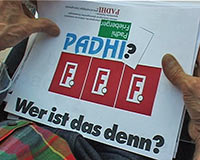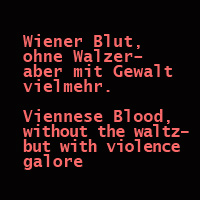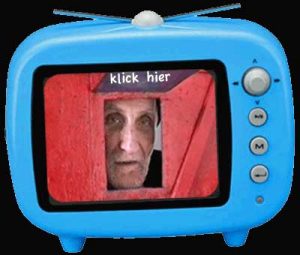ADVERSARIES
Padhi Frieberger: „Die Nazis haben versucht, die Kunst von außen zu zerstören. Die jetzigen Zerstörer haben sich alles unter den Nagel gerissen und zerstören die Kunst von innen.“
A genius is at work here – and nobody takes notice!
This is just the beginning. Now people have taken and will take notice. Padhi is here!
Padhi has been on the periphery of “the scene” for years – no for decades, but he is anything but a peripheral figure. He was always an innovator, always ahead of his time, continuing to work under conditions far from ideal, not letting lack of opportunities or recognition hold him back, not compromising or ingratiating himself to the powers-that-be, speaking and writing his mind regardless of the repercussions.
Padhi is impossible to avoid in post-war Austrian art. He turns up everywhere like Zelig, the Woody Allen character. Zelig, was someone, or rather a nobody who just showed up, that is, he saw to it that he showed up. But although Padhi is omnipresent, he is definitely not a Zelig.
Padhi is referred to as “Padhi doesn’t show up.” I’ve heard this, and my answer is: he showed up in the beginning and he showed up after that, but perhaps now he doesn’t always show up. He doesn’t want to be promoted by a purveyor of junk and he doesn’t want his work to be part of a junk show.
That’s why Padhi has been kept on that siding.
Certainly, Padhi has contributed to being on the periphery. Padhi the artist has stood in the way of Padhi the businessman. That is badly put. There is no Padhi the businessman. There’s just Padhi the artist.
Padhi doesn’t want to be promoted by a purveyor of junk and he doesn’t want his work to be part of a junk show.
He may have cancelled out many of his chances, but he didn’t cancel himself out. There is a price for integrity, and when you pay that price, you often can’t pay the bills. There were times Padhi lived from hand to mouth. But he survived. Yes, Padhi is here!
Young Padhi was buried in the basement of a bombed building in the last phase of the war, before being dug out. And in post-war Austria the cultural powers-that-be did its best to bury him spiritually.
 Padhi goes his way no matter how hard and painful it may be. Not that Padhi wouldn’t like to reap financial fruits! But he has never stooped to pick them up – if attaining them meant stooping. Producing art is more important to him than the monetary aspect. And he produces as well as he can without the benefits and accouterments that money brings. When Padhi works, he has art in mind, not the marketing or the dough or bread that comes from the marketing. For him, art takes precedence over the marketing, since his art is created as art, and not merely as commodity to be sold.
Padhi goes his way no matter how hard and painful it may be. Not that Padhi wouldn’t like to reap financial fruits! But he has never stooped to pick them up – if attaining them meant stooping. Producing art is more important to him than the monetary aspect. And he produces as well as he can without the benefits and accouterments that money brings. When Padhi works, he has art in mind, not the marketing or the dough or bread that comes from the marketing. For him, art takes precedence over the marketing, since his art is created as art, and not merely as commodity to be sold.
Padhi shines in the midst of mediocrity and trend!
Padhi on the game: “Do state-award recipients think that they are being truthful? Can a state-award recipient be an artist? He receives a prize, which is payment for playing the game, and everyone knows what the game is.”
We live in a society in which art is a commodity, and the selling of the product takes precedence over its intrinsic value.
Needless to say, Padhi does not mass produce. There is no assembly line. Padhi’s works are not commercial products.
Here’s more Padhi: “I feel that I am a descendent of modernism. Most of what came after van Gogh, Kandinski or Max Ernst had little to do with the ideas and the attitudes of those trailblazers. Wherever I look, all I see is pseudo development by copycats who are behind the times. They paint and draw, and draw and paint, and sculpt – but artists, that’s not what they are.”
Padhi’s life has been anything but a smooth ride, with a little help from his “friends.”
Here’s an example:
There’s a play by a notable dramatist in which a notable writer decides to build an artist up, and when he’s on the way to the top,  the writer pulls the rug out from under the artist, bringing him all the way down and causing him to commit suicide.
the writer pulls the rug out from under the artist, bringing him all the way down and causing him to commit suicide.
Such delightful behavior is not untypical in the Austrian art scene, and the dramatist had the situation served to him on a silver tray.
The dramatist was Wolfgang Bauer, the writer was Konrad Bayer and the artist is Padhi Frieberger. But things didn’t quite work out the way the way they do in Change. Bayer committed suicide decades ago and Padhi is still very much among us.
Padhi puts it this way: The story is true. Konrad was my friend. But he turned on me in his pitch-black paranoia because he felt that my ability exceeded his. Things took their course, but his malice backfired, and he’s the one who is dead.
Padhi has persevered and survived.
Regretfully Padhi does not keep an index and much of his work has been lost.
Years ago, Padhi filled three thick blank thick books with watercolors. Each page is painted on both sides. I paged through one in Gallery Macura in Vienna, which regrettably is no longer extant. I don’t want to throw the word “great” around, but let me say they are magnificent.
The second cannot be located.
The owner of the third tore pages out and had them auctioned at the Dorotheum, which is Austria’s combination of Christies and Sothebys.

„Kritische.Distanz.nach.allen.Seiten°_Padhi.Frieberger_mailart
We live in a society where art is a commodity, and the selling of the product takes precedence over its intrinsic value.
The paintings of van Gogh, who sold one painting in his lifetime, now sell for millions. But the work of this great artist, whose bitter life ended with suicide, is not bought and sold for its value as art. Van Gogh too, like the products of the charlatans who would not be worthy of licking his boots, is merely bought and sold as a commodity for the sake of speculation.
Padhi, who loves van Gogh, does not fit into the setup.
Padhi on the master: “If I had met van Gogh somewhere in the woods, I would have gone right up to him, for I would have recognized his genius – as well as what he can impart to others.”
“You have to have the genius and the aptitude of an artist in order to comprehend the genius and aptitude of an artist.”
“Genius is an expression of the right thing at the right time.”
“Technical perfection without the total integration of content and unique conception can never result in a work of art.”
Padhi makes comparisons: “The Nazis attempted to destroy art from the outside. Those who practice destruction today have taken over on the inside and destroy art from within.”
-Harry Kuhner










 Users Today : 14
Users Today : 14 Users Yesterday : 21
Users Yesterday : 21 This Month : 338
This Month : 338 This Year : 7094
This Year : 7094 Total Users : 84674
Total Users : 84674 Views Today : 34
Views Today : 34 Total views : 248576
Total views : 248576 Who's Online : 1
Who's Online : 1